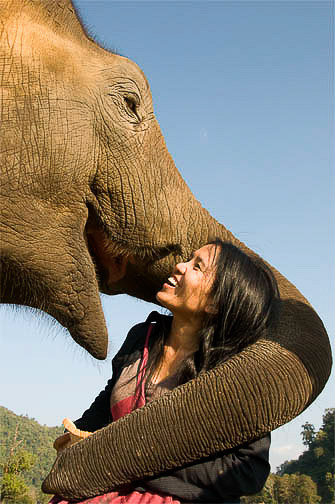(Before It's News)
By Adam J. Pearson

Bliss and Equanimity
When the yoga sutras and Buddhist discourses talk about stabilizing in bliss (ananda), we might think that means like we’d feel like we were having a constant orgasm all day. As great as that sounds like it would be, though, it’s not hard to see that such a state wouldn’t be all that functional or sustainable state for the body. In a constant state of orgasm, there isn’t much room for compassionately feeling-with the suffering of other beings, nor is it easy to get anything done on a practical level with your eyes always rolled back in your head.
By bliss, the seers (rishis) who wrote the yoga sutras mean something far more livable, and if something is to be truly stabilized throughout the day, it must be livable. What they mean my stabilized bliss is something like effortless ease, unconditional well-being, or heartful equanimity. It’s a peace with whatever happens to show up in your body-mind in the present moment, an ease even with resistance and conflict. On a human level, it’s much like being lovingly leaned in and peacefully chilled out.

Forms and Events as Sandcastles
When seen from our deepest nature, the shifting movements in our human life look like the dancing of waves; while they flow through us, we don’t hang on to them, knowing our nature to be the water that rises and falls as the waves and the ocean from which they spring. Thus, waves of sadness, anger, worry, or fear are free to arise and there’s an abiding in the ocean of consciousness in which they appear; in equanimity, they’re felt without holding on or pushing away and known to be impermanent. We are free to enjoy what’s appearing here now while knowing, as the Sufi poets write, that “this too shall pass” (این نیز بگذرد).
When you make a sandcastle on the beach, are you totally and sincerely shocked when a wave carries it away? Do you exclaim to your friends: “OH MY GOD! HOW COULD THIS HAVE HAPPENED? MY ETERNAL SAND FORTRESS HAS BEEN DESTROYED!” You might, but it’s not likely because you know that the sandcastle is impermanent; it’s a temporary expression of form that will dissolve when the conditions that sustain it change. Mindfulness gradually reveals everything that arises to be like a sandcastle. Having realized the sand that appears as all sandcastles, we don’t fret for the arising and dissolution of all of the castles because we know that their core essential nature remains untouched. This is the ground of the stabilized bliss that the sutras describe and it is not an abstract intellectual theory, but a present reality, here, now, right where you are.
Many reflections appear in the mirror, but the mirror remains unmoved. Many clouds appear in the sky, but the sky isn’t lost in their dissolution. Many films appear on the screen, but the screen isn’t blown open by the explosions that appear on it. Many waves arise from the ocean, but the dissolving of a wave does not destroy the ocean. The same is true for life and death, for the play of form arising from the formless. The essential nature of all things, which is our own deepest nature, is neither form nor formless. Realizing it is easy; living from it is difficult, but the benefits are profound. By stabilizing in this realization through continuous daily practice, equanimity is revealed. This is the bliss that the yoga sutras and the Buddhist discourses of the Pali Canon and Mahayana describe. You’re not constantly orgasming, but you’re okay with that.
Equanimity as Okayness With What Arises In You
When you’re serene with things coming and serene with things going, this is equanimity, which is all the bliss we could really need, truly. From this stabilized baseline, we can appreciate whatever peaks come may come along, and we no longer live in a sense of lack when they’re not there; it’s a huge difference from life as usually lived. When the emptiness that dances as what’s happening is realized, the fullness of the present moment is revealed. Sadness arises and you’re okay with it arising; anger arises as your’e okay with it arising. Everything is felt, nothing is grasped onto. No identity is mined out of any of the waves that appear in the ocean of this moment, and if it is, you mindfully see it and are okay with that too.
The movie of human life goes on, and you watch it from the screen while enjoying the appearance of being a character in the film with genes from your parents and a name on your driver’s license. Your character might be an enlightened sage or it might be Larry at the corner store who is unhealthily obsessed with bowling. Whatever the destiny of what Paul Hedderman calls your human “action figure,” you’re okay with it as it is because you know that your true nature is prior to all of the characters that appear on the screen of your life. Knowing that fundamentally you’re not a human being, you’re free to fully be a human being, at peace with whatever life has in store for you.
Thus, another way to put it is that this bliss feels quite like a generalized sense of okayness. That may not sound all that spiritual or fancy–you may not be causing everyone your loving gaze falls upon to twitch on the ground in spiritual ecstasy–but in the living of it, it’s more than enough. We’re not holding on to moments when we “once” were okay or imagining what it will be like when we “will be” okay in the future; we’re unconditionally okay now. If resistance to what happens arises, then we’re okay with feeling resistance. If stress arises, we’re okay with feeling stress. If anger arises, we’re okay with feeling angry. It’s very simple, which is the root of it; if it were complicated, it couldn’t be a baseline of serenity. It can stabilize because it’s so simple. The net result is that, as Paul Hedderman says, although “the geography of your life” may not change, whatever it is, “you travel lighter over it.”
Equanimity and Social Engagement
Does living in a state of equanimity or okayness mean that you disengage from social issues or suffering? Do you sit around all day twitching in spiritual orgasm moaning “there is no one to suffer” while grooving to crystal bowl music and dabbing patchouli oil on your face? Not at all, at least not in my experience. In reality, the way it plays out in your humanness is that you become more deeply engaged, present, and available than before. From this serenity, actions still unfold, but from clarity rather than confusion.
Our little human action figures become of service rather than trying to make everything of service to “me.” As human beings, we surrender to letting responsive action flow through us, based on what’s needed here and now. In my case, for example, this has played out in terms of working as a teacher, psychological statistics tutor, culinary instructor for children with special needs, note-taker for students with visual impairments, mentor for university students, and most recently, student of social work. There is no contradiction between the contemplative life and the life of social action; they are not-two. This is the difference between believing in nonduality as a concept and living it in reality.
As openness deepens, we are more and more available to respond to the needs of others, take social action, participate in advocacy and activism, support those who need us, or do whatever other work needs to be done without inner resistance. On a practical human level, if we see a need to leave an abusive situation or set healthy boundaries that are what’s best for everyone involved, we are okay with that too. Equanimity only makes sense if it’s practical; otherwise, it devolves into a tool for avoidance. And avoidance isn’t equanimity; avoidance has an agenda, which is to escape what’s happening. Equanimity has no agenda and it doesn’t run from what’s happening; it accepts what is. It meets it as it shows up.
Of course, if a feeling of inner avoidance arises, equanimity is okay with that. At the same time, serenity doesn’t move us to check out from life; we’re thoroughly leaned in to what happens, thoroughly engaged, thoroughly available, thoroughly listening, seeing, and responding. How reality will make use of your humanity through service, you’ll find out as it happens. If you’re really open, you may find you get placed in service to people you never thought you’d ever work with. The discovery is part of the fun. And it’s very different from repeating formulaic platitudes like “there is nothing to do and no one to do it” to get out of having to do the dishes.

Equanimity and Compassion
In this way, everything is handled, yet with a sense of lightness. As the Zen Master Bankei says, “all things are resolved in the Unborn.” He doesn’t say that we stop caring about resolution; resolution unfolds, and there’s a lightness around it, an okayness with how it plays out. This lightness is the bliss (ananda) of the sutras. Deep down, we know that everything is perfect as it is–this is the Great Perfection (Dzogchen)–and yet we also know that that that perfection expresses as a world of suffering beings who, on the relative level of daily life, need various kinds of support. Realizing the absolute while discerning and responding to relative needs is living nonduality.
In other words, the essential nature of all things is intrinsically free, and yet in the world of manifestation, many experience hardship, suffering, struggle, and bondage. We can lovingly lean into the discomfort of that. Indeed, that’s what love is all about; would it be love if a mother only loved her baby when she was smiling? Or is her love not revealed in her long hours awake consoling her crying child when she has to work the next morning? The same is true in the spiritual path. Compassion is a leaning in to suffering, a feeling-with. In equanimity, we are okay with this feeling-with. This is how, in nonduality, the deepest revelations of freedom don’t abandon the appearances of the suffering of sentient beings; if that were so, the Buddha, Nisargadatta, and Ramana Maharshi never would have taught.
The seeming paradox of awakening is that we realize our total freedom from everything that has ever happened, and yet this freedom comes home for everyone who seems to be bound. There are no beings separate from us; we are all not-two. Your suffering is my suffering since “you” and “me” are both waves of the same ocean and we are the water that dances as all waves. It is in this intimacy that peace meets suffering, freedom means apparent bondage, and love meets struggle. We see the suffering of refugees, the struggles that people with mental illness face, the hardships of the homeless, the challenges the elderly with Alzheimer’s and, on a human level, we do what we can. This is where compassion meets equanimity; it’s not quite a constant orgasm, but it’s more than enough.



Read More from Adam Pearson at http://philosophadam.wordpress.com/
Source:
https://philosophadam.wordpress.com/2016/11/29/does-living-in-bliss-mean-we-feel-like-were-having-a-constant-orgasm-ananda-and-equanimity/











